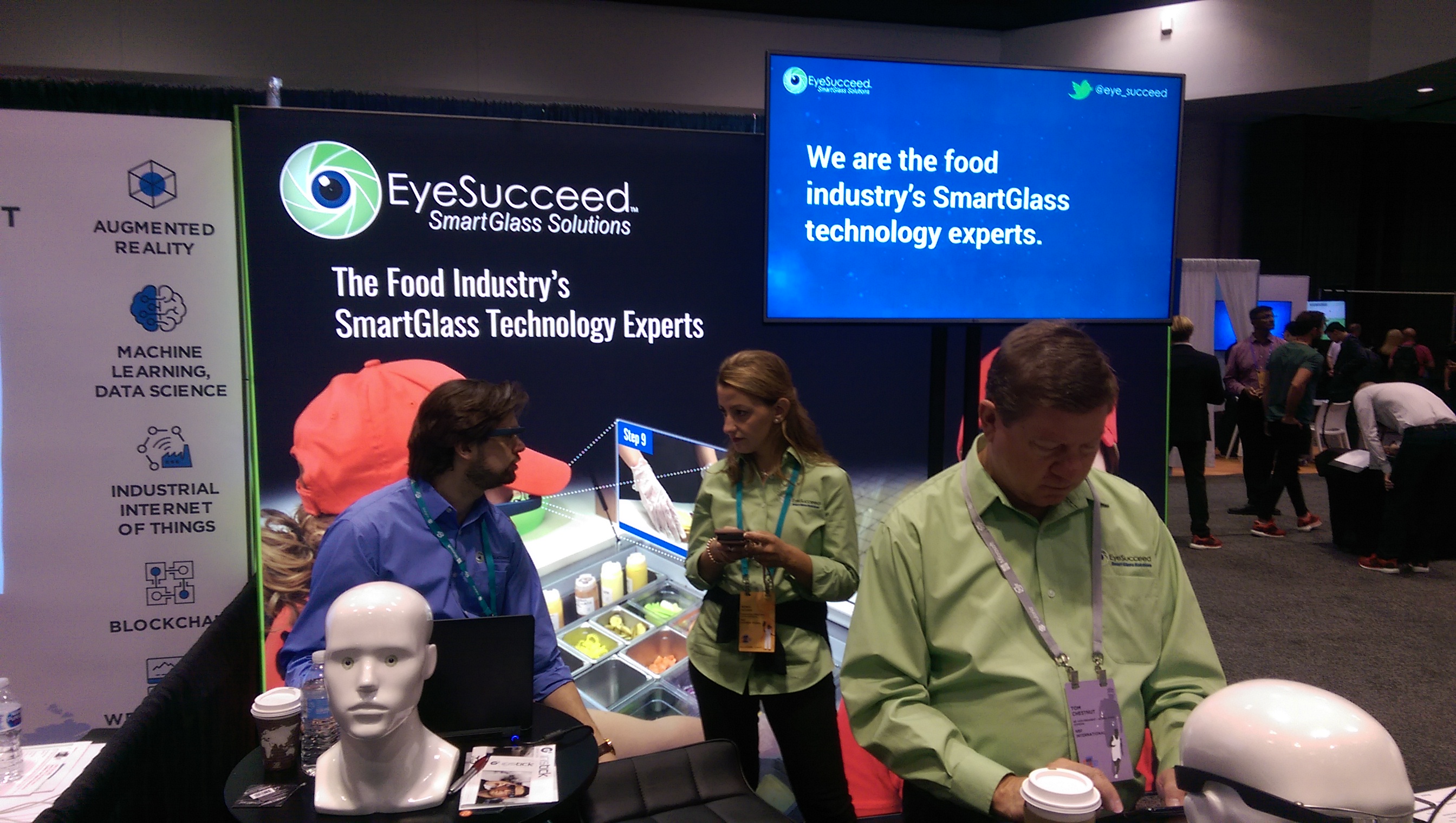The ninth annual Augmented World Expo exhibition and conference was held in Santa Clara, California from May 30 to June 1. Software and application developers for augmented and virtual reality and equipment manufacturers participate in the event - this year AWE visited Unity, Microsoft, and NVIDIA.
The event brought together 6000 participants, 400 speakers delivered reports, 250 companies presented their products at the exhibition. Vasily Tarasevich, Technical Director of HQSoftware, participated in AWE and now shares his impressions.
 Vasily Tarasevich (left) on AWE 2018
Vasily Tarasevich (left) on AWE 2018-
Vasily, tell us about the event. What caught your attention the most?- An important part of this event is sharing knowledge. Industry leaders and small companies share their successes in the development of AR and VR expertise, in the development of software and devices, and this is very cool. Of all the presentations, I liked one most of all, about AR for communications. The idea is very simple - watched Star Wars? There and in other sci-fi films you can see how the characters communicate with the volume holograms of people in real time - that is, the "owner" of the hologram is far from the interlocutors and transmits to them the model of his body and voice. This is technically difficult, but as long as we have a simpler solution. To communicate with a person remotely, you can wear AR glasses and see something like a hologram. It remains only to create an image of this person for broadcast in AR glasses, but it is still much easier than creating a hologram in the movies.
In addition to “teleporting” the speaker’s model, you can also display items with which he interacts. For example, you can create a presentation model so that real and virtual participants in a conversation can interact with it. So far, these technologies are only being investigated, but soon they can be put into practice. Now there are only prototypes.
 Presentation of "Augmented Teleportation" by Mark Billinghurst
Presentation of "Augmented Teleportation" by Mark Billinghurst-
And if you also connect a suit, you can add physical sensations.- By the way, yes. One of the cases of using AR for communications is remote assistance and guidance. The main difference between videoconferences and AR is that in the first case the camera stands motionless throughout the process of transmitting the image, but in AR the viewers can see what the “transmitting” person sees. He moves, turns his head, and viewers see a picture that is being broadcast from a video camera on his glasses. This is more appropriate for the remote manual - for example, an engineer is repairing a machine in production, and can contact more experienced specialists with glasses, show what he is working on now, and get back recommendations on how to handle this machine. Both sides need AR glasses. If they support the recognition of hands, gestures, then an engineer who needs help can see what exactly a more experienced assistant does with his hands and just repeat his movements.
-
Vasily, describe the AWE participants?- I can divide them into several groups. The first is device manufacturers. At the exhibition I saw a lot of AR devices and smart glasses, at least a third of the participants - companies such as Epson, Microsoft HoloLens, Meta and others. Many more companies brought their projects under HoloLens. We talked with Meta - now they probably have the most advanced hand recognition glasses.
In addition to points, there were other AR devices: keyboards, headphones. I talked to representatives of GAudioLab, they make VR headphones — a great idea, we found our own niche in the market, almost no one deals with sound in the AR / VR industry. Let's go back to the points again - companies are trying to add the function of recognizing hand movements in them, in order to give an opportunity to interact with objects in AR. Now we have to use controllers, like for game consoles, gloves with sensors and the like. Embedding the gesture detector directly into glasses is a more progressive idea, LeapMotion developed a “chip” that can be embedded into almost any glasses, and they will recognize hand movements. Feedback in this case is very simple - an object that the user touches, highlights, or is somehow visually highlighted. Of course, there are no physical sensations without gloves or a suit.
Another group of participants is companies that provide “basic” technologies for AR and VR - the so-called computer vision, a set of technologies that satisfy such basic needs as the recognition of markers and flat surfaces. The remaining companies can not be attributed to one group, as they represented a variety of products.
 Stand Eye Glasses EyeSucceed
Stand Eye Glasses EyeSucceedAt AWE, there were still companies that developed AR applications based on a specific business application. Typical cases are learning using AR, visualization, interactive instructions. I met a company that makes AR-tours - their client builds a yacht and wants to see how it looks from the inside while it is not yet ready. For him create a virtual tour. The real estate market can also use technology to represent unfinished buildings, as they look from the inside.
-
In which direction is AR now developing?- Now AR is very personal, isolated, only the user sees a certain AR scene and no one else. Pokémon Go became so popular because in its own way it was the first social AR-application that brought together a huge number of people who saw the same scenes, interacted with the same objects. Now I think AR is moving in this direction - to allow users to share scenes and create them on the go, for example, to post comments in augmented reality on objects right on the street. As in Blade Runner 2049, many technologies from there already exist as simple prototypes. Now the trend is in development - it is such futuristic AR-applications.